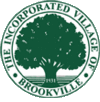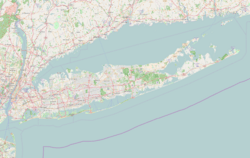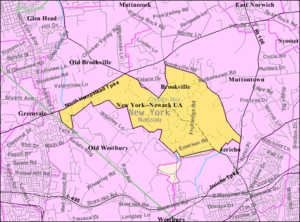Brookville, New York facts for kids
Quick facts for kids
Brookville, New York
|
||
|---|---|---|
| Incorporated Village of Brookville | ||

The DuPont-Guest Estate, one of Brookville's best-known landmarks.
|
||
|
||

Location in Nassau County and the state of New York.
|
||
| Country | ||
| State | ||
| County | Nassau | |
| Town | Oyster Bay | |
| Incorporated | 1931 | |
| Area | ||
| • Total | 3.96 sq mi (10.25 km2) | |
| • Land | 3.95 sq mi (10.22 km2) | |
| • Water | 0.01 sq mi (0.03 km2) | |
| Elevation | 236 ft (72 m) | |
| Population
(2020)
|
||
| • Total | 2,939 | |
| • Density | 744.62/sq mi (287.46/km2) | |
| Time zone | UTC-5 (Eastern (EST)) | |
| • Summer (DST) | UTC-4 (EDT) | |
| ZIP Codes |
11545, 11548
|
|
| Area codes | 516, 363 | |
| FIPS code | 36-10132 | |
| GNIS feature ID | 0944887 | |
Brookville is a small village located on the North Shore of Long Island, in New York. It's part of Nassau County and the Town of Oyster Bay. In 2020, about 2,939 people lived here. Brookville is known for its quiet, green surroundings and large estates.
Contents
History
How Brookville Grew
Brookville officially became a village in 1931. At first, it was a long, narrow piece of land. In the 1950s, it grew much larger. The northern part of an area called Wheatley Hills joined the village. This almost doubled Brookville's size to about 2,650 acres (10.7 km²).
Early Days and Names
When the Town of Oyster Bay bought this land from the Matinecock Native Americans in the mid-1600s, it was called Suco's Wigwam. Many early settlers were English and Quakers. Later, Dutch settlers arrived from western Long Island. They called the area Wolver Hollow. This name likely came from wolves that gathered to drink at Shoo Brook.
For most of the 1800s, the village was known as Tappentown. This was after a well-known family. After the Civil War, people started calling it Brookville. This name appeared on maps by 1873.
The Gold Coast Era
For two centuries, Brookville was mostly farmland and woods. But in the early 1900s, this changed fast. Wealthy New Yorkers began building huge mansions here. By the mid-1920s, there were 22 large estates. This was part of the "Gold Coast" boom on Nassau's North Shore.
One famous estate was Broadhollow. It was a 108-acre (0.44 km²) property with a 40-room manor house. Winthrop W. Aldrich, a lawyer, banker, and diplomat, owned it first. Later, Alfred Gwynne Vanderbilt Jr., who owned famous racetracks like Belmont, bought it.
Another grand estate was Hillwood. It had a lavish 70-room mansion on 178 acres (0.72 km²). Marjorie Merriweather Post, whose father created Post cereals, and her husband Edward Francis Hutton, a famous financier, built it.
Village Incorporation and Landmarks
In 1931, the estate owners worked together to make Brookville an official village. They wanted to stop unwanted building in other parts of Nassau County. W. Deering Howe was the first Mayor.
In 1947, the Post estate was sold to Long Island University. It became the C. W. Post campus, now known as LIU Post. This campus is home to the Tilles Center for the Performing Arts.
Another important building in Brookville is the DeSeversky Conference Center. It belongs to the New York Institute of Technology. This center used to be Templeton, the mansion of socialite Winston Guest. Templeton was even used as a setting for the movie Arthur.
Historic Churches and Preserves
A very old church, the Chapelle de St. Martin de Sayssuel, also known as the St. Joan of Arc Chapel, was moved to Brookville. It was brought stone by stone from France in 1926. This is where Joan of Arc prayed before battles. It was later moved to Marquette University in Wisconsin.
The Brookville Reformed Church is one of the oldest church congregations in the United States. It was founded by Dutch settlers in the 1600s.
The James Preserve is a nature area near Brookville. It shows what the village looked like naturally before it was developed.
Wealthiest Town
In 2009, BusinessWeek magazine called Brookville the wealthiest town in America. This was based on average income and net worth.
Geography
Brookville covers about 4.0 square miles (10.25 km²) of land. It is located entirely on land, with no major bodies of water within its borders.
Demographics
| Historical population | |||
|---|---|---|---|
| Census | Pop. | %± | |
| 1940 | 204 | — | |
| 1950 | 337 | 65.2% | |
| 1960 | 1,468 | 335.6% | |
| 1970 | 3,212 | 118.8% | |
| 1980 | 3,290 | 2.4% | |
| 1990 | 3,716 | 12.9% | |
| 2000 | 2,126 | −42.8% | |
| 2010 | 3,465 | 63.0% | |
| 2020 | 2,939 | −15.2% | |
| U.S. Decennial Census | |||
In 2020, Brookville had a population of 2,939 people. The village is known for its spacious homes and quiet atmosphere.
In 2009, Brookville was named the wealthiest town in America by BusinessWeek. This was based on the average income and net worth of its residents.
Education
K-12 Schools
Most students in Brookville attend schools in the Jericho Union Free School District. Some parts of the village are served by the Locust Valley Central School District.
The Long Island Lutheran Middle and High School is also located within Brookville.
Colleges and Universities
Brookville is home to parts of two major college campuses:
- Half of the New York Institute of Technology's Old Westbury campus is in Brookville. This campus is about 1,050 acres (4.2 km²) in size.
- The village also hosts LIU Post. This is the largest campus of the private Long Island University system.
Notable people
Many interesting people have lived in Brookville, including:
- Winthrop W. Aldrich, a U.S. ambassador.
- Marc Anthony, a famous singer.
- Angie Dickinson, an actress.
- Alfred I. du Pont, an inventor and generous giver.
- Prince Felix and his family from Luxembourg.
- C. Z. Guest, a well-known socialite.
- Edward Francis Hutton, who helped start a famous financial company.
- Marjorie Merriweather Post, a philanthropist and heiress.
- Alfred Gwynne Vanderbilt Jr., who owned famous racetracks.
See also
 In Spanish: Brookville (Nueva York) para niños
In Spanish: Brookville (Nueva York) para niños





